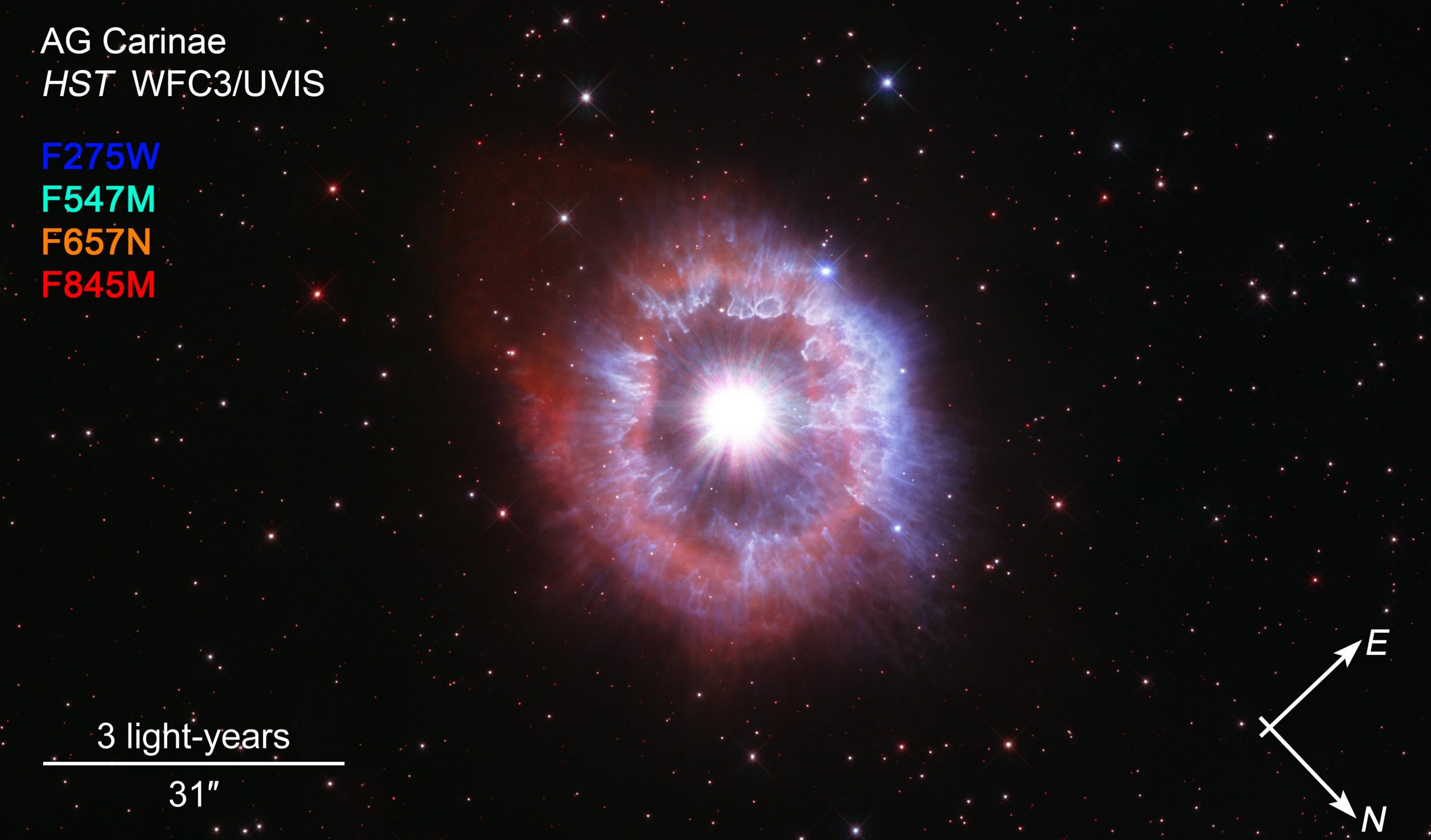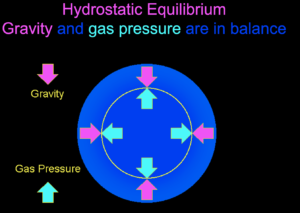
Composite image of AG Carinae in 4 wavebands (3 visible and 1 ultraviolet) using Hubble’s Wide Field Camera 3 and Ultraviolet Imaging Spectrograph. Scale included for context: 3 light years is 31 arc seconds in this image with northeast to the right and southwest to the left. It’s interesting to note that the distance of 4.3 light years between our solar system and our nearest stellar neighbors, the Alpha Centauri system, would be contained within the envelope of ejected gas from AG Carinae.
By James Daly, Ph.D
NASA Video at foot of article
NASA Hubblesite news release here
On the occasion of the Hubble Space Telescope’s 31st successful year in orbit last Saturday (4/24, launch date: 4/24/1990), the iconic orbiting telescope was tasked with capturing AG Carinae, a blue supergiant star in the southern constellation of Carina. This constellation is also home to Eta Carinae, a stellar system containing at least two stars with a combined luminosity greater than five million times that of the Sun!
The primary star in the Eta Carinae system, like AG Carinae, is also on the verge of destruction and will end its life in spectacular fashion as a Type II supernova in the [astronomically] near future, is a peculiar star, similar to AG Carinae, a luminous blue variable (LBV). The primary star in the Eta Carinae system was initially 150–250 solar masses and now has lost at least 30 solar masses of material; it is also the only star known to produce ultraviolet laser emission.
Along with Eta Carinae, AG Carinae is one of the brightest stars in our galaxy with a luminosity in excess of 1 million times that of the sun! A freshman astronomy student quickly learns that a fundamental relationship exists between a star’s mass and luminosity. This relationship, not unexpectedly, is called the “Mass-Luminosity” relation with a star’s luminosity varying close to the 4th power of a star’s mass. In other words, a star that is twice the sun’s mass would shine with a luminosity16 or 24 times greater than that of the sun. Mass estimates of AG Carinae place it between 32 at a minimum to above 70 solar masses with a corresponding radius above 50 solar radii and a luminosity in excess of 1 million times that of the sun!
 Behemoths such as these evolve, live and die within the space of 10 – 30 million years while tiny stars by comparison such as our sun have life-spans 3 orders of magnitude (1,000 times) greater. This dependency of life-span on mass is directly linked to the mass-luminosity relation and is well understood.
Behemoths such as these evolve, live and die within the space of 10 – 30 million years while tiny stars by comparison such as our sun have life-spans 3 orders of magnitude (1,000 times) greater. This dependency of life-span on mass is directly linked to the mass-luminosity relation and is well understood.
As our hypothetical astronomy student continues their studies, he or she will come to learn about hydrostatic equilibrium where the outward gas and radiation pressure produced by the 20 million degree nuclear fusion reactor that is a star’s core is balanced by the inward crush of gravity: the Sun and all stars are dynamic, self-regulating systems, each powered by a huge nuclear fusion reactor in their core.
As the mass of the star increases, the amount of energy necessary to maintain the balance of Hydrostatic Equilibrium increases according to the increase in volume or the 3rd power of the star’s radius (assuming constant density). This required increase in energy necessary to maintain Hydrostatic Equilibrium means the star will burn through its compliment of core hydrogen, its nuclear fuel, at an ever increasing rate according to the increase in mass. Stars such as AG Carinae, such “Celebrity”, ultra-bright, “Glamorous” stars live fast and die young.
There is an upper limit to just how massive a star can be. That point is where the gas and radiation pressure exceeds the crush of gravity. The star mentioned above, the primary star in the Eta Carinae system, is one such star between 150–250 solar masses. The effects of this enormous outward pressure is exemplified in the Hubble image above and in the corresponding video below with the ejected bubble of gas that surrounds AG Carinae. This ejected shell is an aspect of such a massive star’s late-stage evolution and one that shines by the powerful ionizing (UV) radiation emitted by the star.
It’s interesting to note that the distance of 4.3 light years between our solar system and our nearest stellar neighbors, the Alpha Centauri system, would be contained within the envelope of ejected gas from AG Carinae!
Such Luminous Blue Variables (LBVs) are prone to convulsive fits, expanding in size like hot air balloons, shedding their outer layers of material into space as described above. One or more such giant eruptions that occurred about 10,000 years ago created this beautiful, expanding shell of dust and gas. Stars such as AG Carinae are quite rare with current estimates placed at less than 50 such stars residing in our Milky Way galaxy and local group of galaxies.
Hubble Fun Facts
- Launched on April 24, 1990, NASA’s Hubble Space Telescope has made more than 1.5 million observations of about 48,000 celestial objects.
- In its 31-year lifetime, the telescope has racked up more than 181,000 orbits around our planet, totaling over 4.5 billion miles.
- Hubble observations have produced more than 169 terabytes of data, which are available for present and future generations of researchers.
- Astronomers using Hubble data have published more than 18,000 scientific papers, with more than 900 of those papers published in 2020.
Astronomy For Change: https://astronomyforchange.org
Buy us a Coffee? https://www.buymeacoffee.com/astronomychange
Follow Us On Twitter: https://twitter.com/astronomychange
Why not support us on Patreon: https://www.patreon.com/astronomyforchange
Imagination is more important than knowledge
![]()
An index of all articles can be found here.
If you enjoyed this article, please consider supporting us with a modest donation
or through a subscription on our Patreon Page
Membership at Astronomy for Change is Free!



